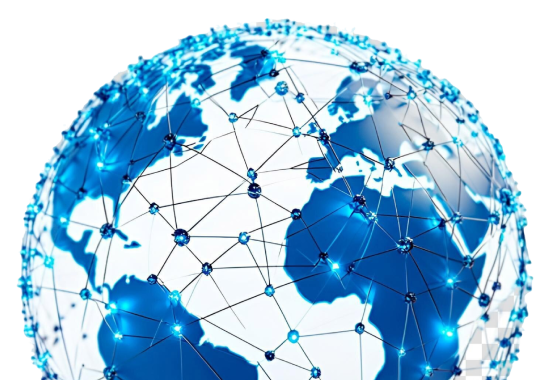Networking




Networking
Networking is the practice of connecting multiple computing devices (such as computers, servers, printers, and other hardware) to enable communication and resource sharing. It is an essential technology in both personal and professional environments, facilitating everything from accessing the internet to sharing files and printers within an organization.
A computer network can be as simple as a local area network (LAN) within a home or office or as complex as a global network like the internet, which connects billions of devices worldwide. The goal of networking is to allow devices to share information, resources, and services efficiently and securely.
Types of Computer Networks
- Local Area Network (LAN): A network confined to a small geographical area, such as a home, office, or campus. It connects computers and devices within that area, providing high-speed communication.
- Wide Area Network (WAN): A network that covers a large geographical area, often connecting multiple LANs. The internet is the most common example of a WAN.
- Metropolitan Area Network (MAN): A network that covers a larger area than a LAN but smaller than a WAN, such as a city or a large campus.

Active and Passive Networking Components
In computer networking, there are two main types of components: active and passive. These components play different but complementary roles in facilitating communication within a network.
Active networking components are devices or elements that require power and perform processing or control functions in a network. These devices are responsible for transmitting, routing, or managing data traffic.
1. Routers:
- Routers are devices that forward data packets between different networks (such as between a home network and the internet). They determine the best path for data transmission using routing protocols.
2. Switches:
- Switches operate within a LAN and connect devices like computers, printers, and servers, enabling them to communicate with each other. They forward data based on the MAC (Media Access Control) address of devices within the network.
3. Firewalls:
- Firewalls are security devices or software that monitor and control incoming and outgoing network traffic. They help protect the network by blocking unauthorized access and filtering data based on predefined security rules.
4. Access Points (APs):
- Wireless Access Points allow Wi-Fi-enabled devices to connect to a wired network. They extend the range of a network by providing wireless connectivity.
Passive networking components, on the other hand, do not require power to perform their functions. They are responsible for transmitting and receiving data but do not perform any processing or control tasks. These components are essential for the physical connection and transmission of data within the network.
1. Cables (Ethernet, Fiber Optic, etc.):
- Cables are the primary medium used to transmit data between devices in a network. Ethernet cables (twisted pair) and fiber optic cables are commonly used to connect devices over short or long distances.
2. Patch Panels:
- Patch panels are used to organize and manage network cables. They allow for the centralization of connections in a network, making it easier to connect and reroute cables as needed.
3. Connectors and Jacks:
- Connectors, such as RJ45 connectors (used with Ethernet cables), and jacks are used to physically connect network cables to devices, such as computers, switches, and routers.
4. Cable Management Systems:
- These systems are used to organize, secure, and route cables in a structured manner to avoid tangling and ensure efficient data flow.
Benefits of Computer Networking:
Computer networking brings a wide range of benefits to individuals, businesses, and organizations. The advantages include everything from improved efficiency to enhanced communication and resource sharing.
1. Resource Sharing:
Networking enables the sharing of resources, such as printers, files, and internet connections, across multiple devices within a network. This eliminates the need for duplicate hardware and promotes cost savings.
2. Communication and Collaboration:
Networking facilitates communication through various channels, such as email, instant messaging, video conferencing, and voice over IP (VoIP). This supports collaboration among individuals, teams, and organizations, regardless of their geographical location.
3. Cost Savings:
By centralizing resources, networking reduces the need for duplicate devices and equipment. It also enables businesses to cut down on travel expenses and operational costs by using remote communication tools.
4. Centralized Data Management:
In a networked environment, data can be stored on centralized servers, making it easier to manage, back up, and access. This improves data security, reliability, and consistency across the network.
5. Scalability:
Networking provides scalability, meaning businesses can easily expand their networks to accommodate additional devices, users, or resources. This is essential for organizations that anticipate growth or need flexibility in their infrastructure.
6. Remote Access:
Networking allows remote access to systems and data. This is especially valuable for businesses that have employees working from home, traveling, or working in different locations. Technologies like Virtual Private Networks (VPNs) ensure secure remote access.
7. Improved Security:
Networks can be secured using firewalls, encryption, and authentication protocols, providing layers of protection against unauthorized access, data breaches, and cyber threats. Businesses can set up security policies to monitor and protect sensitive data.
8. Improved Security:
Networks can be secured using firewalls, encryption, and authentication protocols, providing layers of protection against unauthorized access, data breaches, and cyber threats. Businesses can set up security policies to monitor and protect sensitive data.
9. Improved Security:
Networks can be secured using firewalls, encryption, and authentication protocols, providing layers of protection against unauthorized access, data breaches, and cyber threats. Businesses can set up security policies to monitor and protect sensitive data.
10. Improved Security:
Networks can be secured using firewalls, encryption, and authentication protocols, providing layers of protection against unauthorized access, data breaches, and cyber threats. Businesses can set up security policies to monitor and protect sensitive data.
11. Improved Security:
Networks can be secured using firewalls, encryption, and authentication protocols, providing layers of protection against unauthorized access, data breaches, and cyber threats. Businesses can set up security policies to monitor and protect sensitive data.
